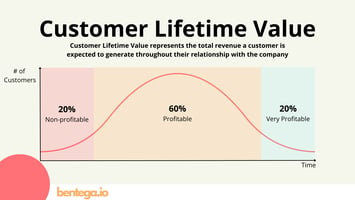Customer Retention Rate: Why it Matters
Customer retention is a key determinant of long-term success and sustainability. The Customer Retention Rate (CRR) metric plays a pivotal role in measuring the effectiveness of a SaaS company's efforts in retaining customers over time. This article delves into the significance of tracking CRR in SaaS businesses, provides examples, and discusses strategies to improve this critical metric.
What is Customer Retention Rate (CRR)?
Customer Retention Rate (CRR) is a crucial metric employed by businesses to quantify the percentage of customers that continue to use a company’s products or services over a designated period. Like Net Revenue Retention, this measurement serves as a key indicator of a company’s proficiency in maintaining customer engagement, satisfaction, and loyalty, which are essential components in fostering long-lasting relationships with clients. Calculating CRR involves a straightforward formula: divide the number of customers who remain with the business at the end of the specified period (adjusted for churn) by the total number of customers at the start of that period, and then multiply the result by 100 to express it as a percentage.
This metric provides valuable insights into the effectiveness of a company’s retention strategies, highlighting their success in meeting customer needs and expectations. By understanding CRR, businesses can identify strengths and areas needing improvement in their customer retention efforts, ultimately leading to more strategic planning and decision-making to enhance overall business performance.
Customer Retention Rate Calculation Formula
To explain the calculation formula we would like to present an example. Let's consider a hypothetical SaaS company that provides project management software. At the beginning of the year, the company had 500 customers. Over the course of the year, it lost 50 customers but retained 450 customers by the end of the year.
How to Calculate Customer Retention Rate
Customer Retention Rate = (Customers at the End of the Period / Customers at the Beginning of the Period) x 100
CRR = (450 / 500) x 100 = 90%
The Customer Retention Rate for this SaaS company is 90%, indicating a strong ability to retain customers over time.
What is a good Customer Retention Rate?
Determining what constitutes a "good" Customer Retention Rate (CRR) can vary significantly depending on the industry and the specific business model of a SaaS company.
Generally, a CRR of 85% or higher is considered excellent in the SaaS sector, as it indicates that the company is successfully maintaining a strong relationship with its customer base. However, it's important to benchmark against industry standards and competitors to gain a more accurate perspective. For instance, a CRR of 90% might be exceptional in a highly competitive market, while in a niche market with fewer alternatives, the expectations might be even higher. Ultimately, a good CRR is one that not only meets but exceeds industry averages, reflecting a company's ability to deliver consistent value and satisfaction to its customers, thereby ensuring long-term business growth and stability.
Also, as customers can vary significantly in terms of value, a lower customer retention rate does not necessarily mean that the company is unsuccessful i.e. if the customers that are leaving have lower ACV. In those instances, it would be more interesting to look at KPIs such as Gross and Net Retention Rate.
Importance of Tracking Customer Retention Rate
- Revenue Stability: High Customer Retention Rate ensures a steady stream of recurring revenue from existing customers, reducing dependency on acquiring new customers to sustain business growth.
- Cost Efficiency: Acquiring new customers typically costs more than retaining existing ones. By focusing on customer retention, SaaS businesses can optimize their marketing and sales expenses and improve company profitability.
- Customer Lifetime Value: A strong Customer Retention Rate contributes to higher Customer Lifetime Value (CLV) as loyal customers tend to generate more revenue over their lifetime through repeat purchases and upsells.
- Positive Reputation: A high Customer Retention Rate reflects positively on a SaaS company's reputation and brand image, signaling to prospective customers that the company is trusted and valued by its existing customer base.
Strategies to Improve Customer Retention Rate
- Proactive Customer Support: Offer proactive and responsive customer support to address issues and inquiries promptly. Anticipate customer needs and provide personalized assistance to enhance satisfaction and loyalty.
- Continuous Engagement: Keep customers engaged with your SaaS product through regular communication, product updates, and value-added resources. Provide educational content, webinars, and tutorials to help customers maximize the value of your product.
- Tailored Offerings: Personalize offerings and experiences based on customer preferences and usage patterns. Segment customers into groups based on their needs and interests and tailor marketing messages and product recommendations accordingly.
- Customer Feedback Loop: Establish a feedback loop with customers to gather insights into their experiences, preferences, and pain points. Act on customer feedback to address concerns, make improvements, and demonstrate responsiveness.
- Retention-focused Pricing: Implement pricing strategies that incentivize long-term commitment and loyalty. Offer discounts or rewards for annual subscriptions, referrals, or upgrades to encourage retention and reduce customer churn.
- Proactive Churn Prevention: Monitor customer behavior and engagement metrics to identify at-risk customers and intervene proactively. Implement retention campaigns, special offers, or personalized outreach to re-engage customers and prevent churn.
Conclusion
Customer Retention Rate (CRR) is a vital KPI for assessing the health and sustainability of SaaS businesses. By tracking CRR, SaaS companies can gauge their ability to retain customers over time, identify areas for improvement, and implement strategies to enhance customer satisfaction and loyalty. By prioritizing proactive customer support, continuous engagement, tailored offerings, customer feedback, retention-focused pricing, and proactive churn prevention, SaaS businesses can strengthen their CRR and drive sustained growth and success in the competitive market landscape. Remember, retaining existing customers is just as important as acquiring new ones – if not more so – in building a thriving SaaS business.
Visit Bentega.io today and subscribe to our newsletter to get more useful tips directly in your inbox.
.jpg?width=960&height=540&name=Business%20Performance%20Metrics%20download%20free%20guide%20(1).jpg)



What CRR do you strive for?